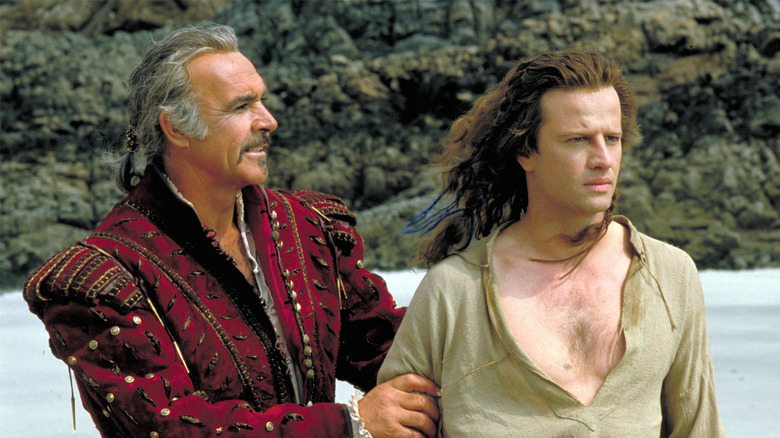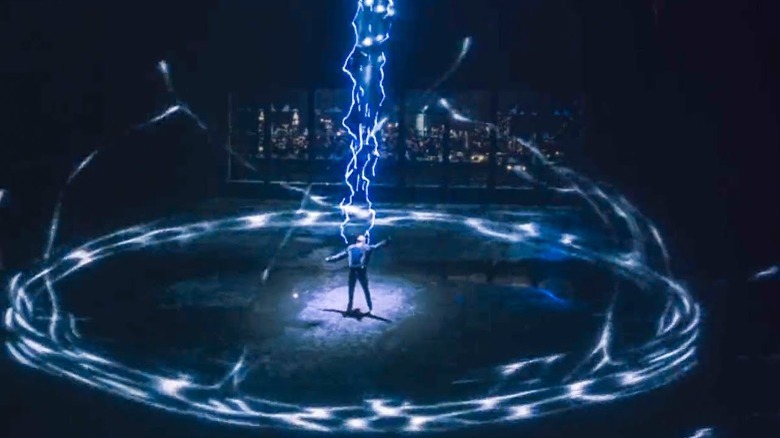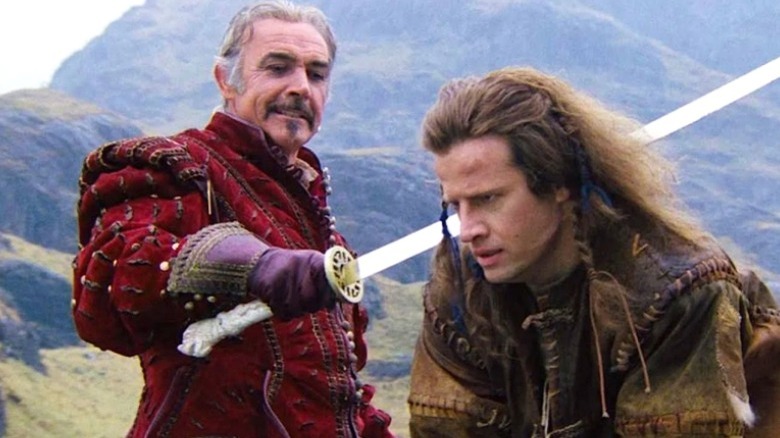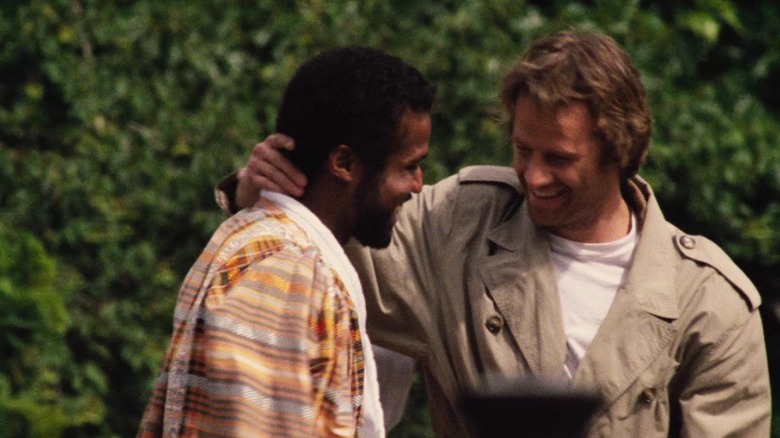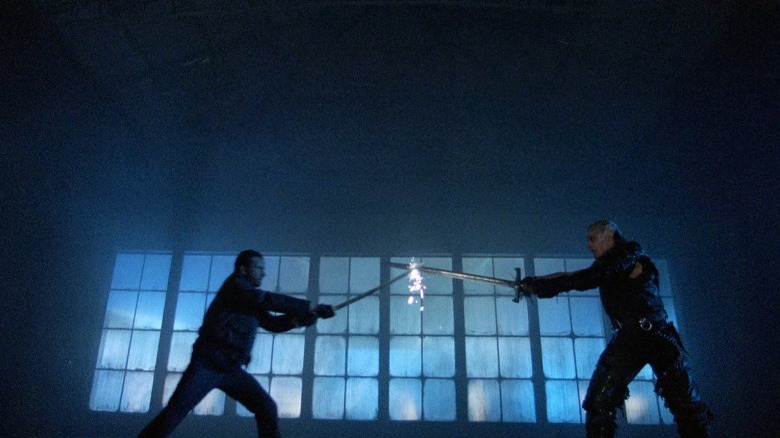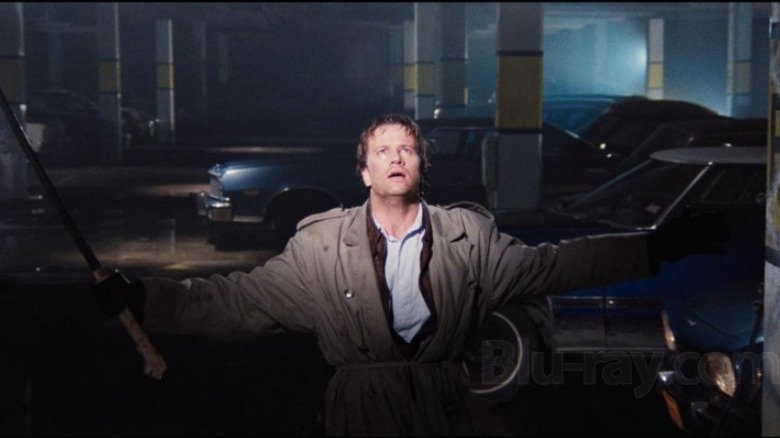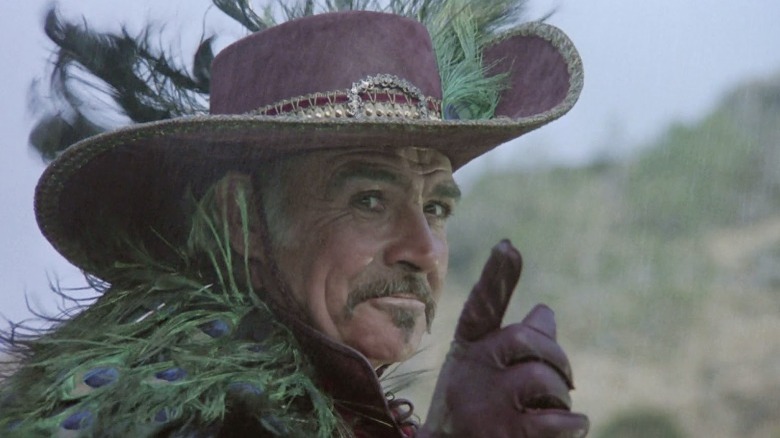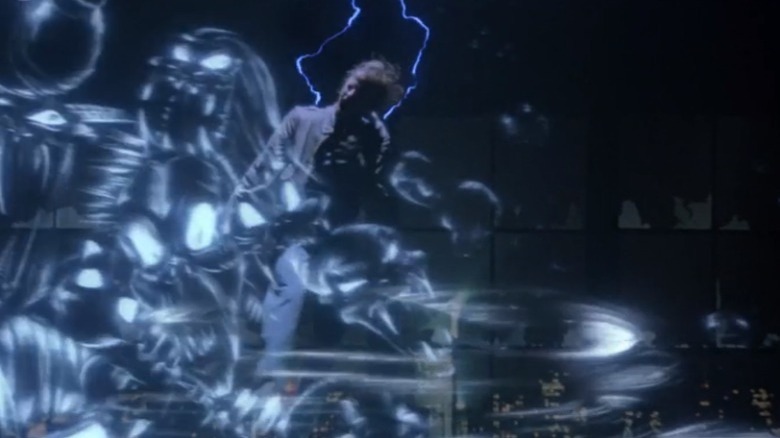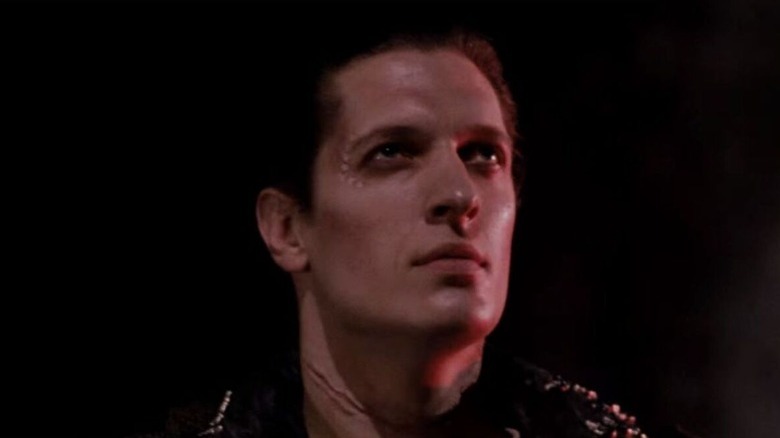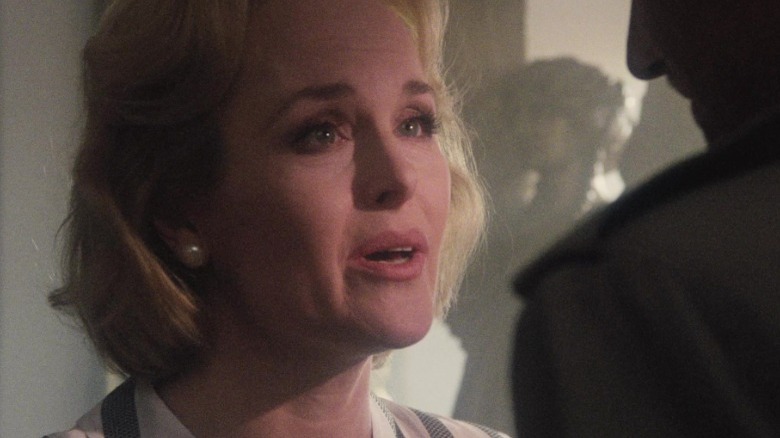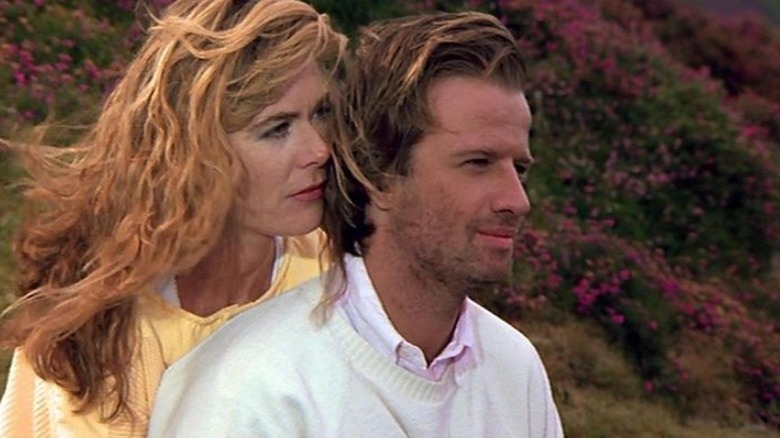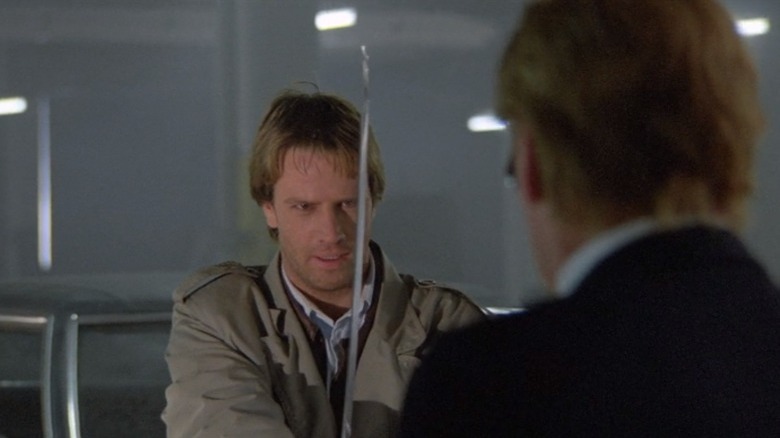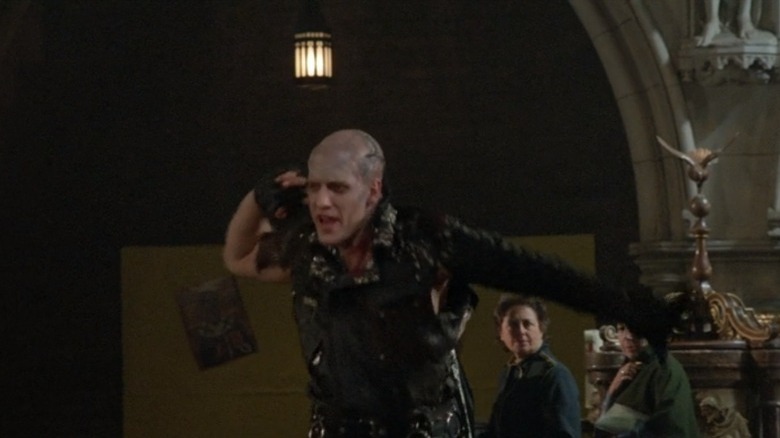The Ending Of Highlander Finally Explained
Like the characters in the movie "Fame," we've all wished we could live forever at some point. Unfortunately, we all pass away at some point. There are plenty of potential coping mechanisms to employ when we're faced with our own mortality, including popping on a classic story about immortals like the original 1986 "Highlander," and living vicariously through the characters in the film. And while we're being narcissistic and hoping to cheat death, we can also play along and imagine fighting to be the last immortal standing.
The decades since the movie's release have brought us an expansive "Highlander" franchise that includes four sequels, a spin-off television series that ran for six seasons, an animated series, and even an anime. So it's actually surprising to realize how little the original "Highlander" bothers to explain how anything works, or what "The Quickening" and "The Prize" actually are. The movie is mostly built on vibes: It was directed by Russell Mulcahy, who had mostly directed music videos to that point in his career, and it shows. In the best way possible, "Highlander" is an excuse to film some exciting sword fights, and not to worry too much about either exposition or resolution along the way. Let's revisit a home-video classic and sort out what we can. Note that this article engages with "Highlander" on its own terms: The direct sequel "Highlander II: The Quickening" retconned most of the original, and subsequent sequels just pretended it didn't exist. This is the ending of "Highlander," finally explained.
Immortals and the Quickening
It cannot be overstated how content "Highlander" is to let us fill in the blanks of its metaphysics. The basic idea is pretty straightforward: A select few people throughout history (we meet only five in total) are born immortal, and are virtually unable to be killed. In most movies with a new supernatural form of life – vampires or werewolves or what have you – some sort of monster or occult expert will show up and hold our hands, walking both the main character and the audience through the logistics. Vampires have to wait to be invited into your home, werewolves have a crippling silver allergy, that sort of thing.
In "Highlander," the closest we get is when Juan Sánchez-Villalobos Ramírez (Sean Connery) arrives in Scotland to show young Connor MacLeod (Christopher Lambert) how to sword fight. Amidst endless battle training, he explains that immortals will someday fight for the right to be the last one alive, and whoever does will claim "The Prize," some sort of ultimate power. But "The Quickening," which in the television spin-off is clearly described as a transfer of power and knowledge when one immortal kills another, in "Highlander" is just a general charge in the air when two immortals are near one another. Lightning strikes MacLeod when he and Ramírez first encounter each other, and a heightened sensation he feels when communing telepathically with animals is also described by Ramírez as a form of the Quickening.
Achilles' necks
The key detail that Ramírez does let MacLeod in on is the one way that immortals can die. While embarrassing MacLeod with his far superior dueling skills (and his smug Sean Connery energy), he puts it simply: "if your head ever comes away from your neck, it's over." Like more articulate, less brain-hungry zombies, immortals can take any manner of damage other than a direct beheading. This doubles as a handy explanation for why they all prefer swords to guns when fighting one another in the present day.
Their necks appear to be the only part of their bodies that can also be permanently injured. Centuries after Ramírez slashes the Kurgan (Clancy Brown) across the throat, he's shown to have a prominent scar on his neck in the modern age, and also to have a more gravelly voice, indicating lingering damage to his vocal cords. At no point do we see an immortal wearing any kind of protective chainmail or armor over their only vulnerability, however, which would seem like a logical move.
The Gathering in a faraway land
As promised by Ramírez, the remaining four immortals in the '80s are all drawn to a "faraway land" from Scotland: New York City. The city that never sleeps is the battleground that MacLeod, the Kurgan, Iman Fasil (Peter Diamond), and Sunda Kastagir (Hugh Quarshie) are all irresistibly drawn to, although Kastagir and MacLeod apparently find the urge to fight one another easy to resist, and embrace each other as old friends. Curiously, during the 1500s when Ramírez is explaining the concept of the Gathering, the area that would become New York City was just a sparsely populated settlement of the Lenape tribal nation, so it's unclear why it would be the final battleground.
It's also not really explained how much agency any given immortal has in choosing whether to befriend or fight one another. Three of the five immortals we actually meet in "Highlander" are benevolent: MacLeod, Kastagir, and Ramírez. But the Kurgan, operating on an instinctive awareness that MacLeod is immortal before MacLeod himself is even aware in 1536, is utterly committed to becoming the final survivor, forcing our hero's hand at the end of the movie.
The Prize and the future of humanity
The Prize for being the last immortal turns out to be even more than MacLeod could have ever hoped for: He's now mortal, and can live out his days with his new sword-expert love interest Brenda (Roxanne Hart), sparing him the pain of watching another lover grow old and die without him. The Prize also means that he's one with all living things, and can sense the thoughts of every person on Earth if he concentrates hard enough on the "whirlwind" in his head, a power that he hopes to use to "help them understand each other."
With only four immortals left, the "tournament" in "Highlander" is kind of a letdown: MacLeod defeats Fasil, the Kurgan takes out Kastagir, and then MacLeod wins an epic duel with the Kurgan. It might have helped to know the actual stakes involved: With the power of the Prize, the Kurgan would indeed have been able to usher in "an eternity of darkness" for humanity, as Ramírez foretold.
No more immortals?
At the end of "Highlander," MacLeod is the last of his kind, and either is rendered mortal by the Prize or chooses to become so. It's unclear if that means that there will never be any immortal beings ever again, or if the cycle will restart after MacLeod's death. It once again boils down to the mystery of how, exactly, Ramírez knows all of the immortal "lore" that he passes on to MacLeod in the first place.
At one point he invokes the word "tradition," when referring to the practice of not fighting "on holy ground." So are the Gathering and the compulsion to fight to the death also considered traditions? Is it a "Battlestar Galactica" style case of "all of this has happened before and will happen again," a cycle of immortals killing each throughout the ages? Subsequent "Highlander" movies and shows explore this in different ways, but in 1986 it was all hypothetical. Rather than examining what would happen after the events of the original, the majority of the sequels and spin-offs just imagine that he never achieved the Prize in the first place.
Where was Ramírez from exactly?
No discussion of "Highlander" would be complete without a serious conversation about accents. Christopher Lambert was famously cast as Connor MacLeod after director Russel Mulcahy saw a photo of him in a magazine (via Telegraph), unaware that Lambert, having grown up in Switzerland and France, was not a native English speaker. Lambert's Scottish accent in the flashbacks and his more generic accent in the '80s scenes are collectively regarded as one of the worst on-screen accents of all time. An even bigger distraction is the Spanish (but originally Egyptian?) Ramírez, who speaks with Sean Connery's unmistakable Scottish accent, even though MacLeod is allegedly the Scottish one.
The most generous way to read both cases is to, well ... blame it on immortality. Ramírez, who's well into the third millennium of his life, has lived in countless different places and probably adopted the local language every time. One could even posit that in order to blend in while seeking out MacLeod in Scotland, he's using a Scottish accent in order to avoid drawing attention to himself. MacLeod, for his part, also speaks with a shifting, vaguely European accent in the present day because of his 400+ years of experience.
The final Quickening and the evil spirits
There is no in-movie explanation for the faces that appear around MacLeod after he beheads the Kurgan. Obviously, having defeated the last remaining immortal, MacLeod is due for an extra-intense Quickening that bestows the power of the Prize: In addition to the usual lighting and exploding glass, he's lifted into the air and exclaims "I know everything! I am everything!" Still, he seemingly has to do battle, however briefly, with the dark and demonic energy that the Kurgan seemed to exude from his pores. Like hand-drawn, light cousins of the hell-demons in "Ghost," they swarm him in the air and then dissipate.
The fourth season of "Highlander: The Series" takes this moment and gives it a name, referring to it as a "Dark Quickening." Basically, when an evil immortal is killed, the dark energy of the resulting Quickening can overwhelm the victor and turn them evil as well. Fortunately, MacLeod isn't overtaken by the sadistic, malevolent spirit of his departed nemesis.
The Kurgan's ancient origins
By far the character in "Highlander" having the most fun is the bad guy known as the Kurgan, who brings a chaotic energy to every single scene he appears in. In a couple of efficient sentences, Ramírez sums up his character: "The Kurgans were an ancient people, from the steppes of Russia. For amusement, they tossed children into pits with hungry dogs to fight for meat." The Kurgan's subsequent disregard for civilian life (and church etiquette) is in keeping with the idea of his ancient, savage origins.
His name is actually an anachronism. The term "kurgan cultures" was developed in the 20th century by anthropologists to refer to several different nomadic cultures in the region (via Current Anthropology), it's extremely unlikely that anyone from the 1500s would refer to "the Kurgans" from the Russian steppes. And since there's little recorded history of the Eastern Slavs, the region that became Russia, until about the 9th century AD, there's no way to back up the "children into pits" comment, which by all accounts is an invention of screenwriter Gregory Widen.
What happens to Rachel?
As far as we can tell from the brief epilogue of "Highlander," MacLeod keeps his promise not to return to his life as "Russell Nash" whether he defeated the Kurgan or not, and so his goodbye to his longtime companion Rachel (Sheila Gish) remains final. Presumably, this means that she takes over his antique business, which by all appearances was very lucrative, thanks to MacLeod's multiple centuries of collecting. He mentions having left paperwork behind granting her power of attorney, which perhaps entitles her to his fancy house as well.
However, at least one member of law enforcement is aware of Russell Nash's long history of changing identities, due to some absurdly futuristic handwriting analysis software. It seems very possible that either the NYPD or the IRS will interfere with Rachel on the technicality that Russell Nash died in infancy, at least on paper. Everything MacLeod left her could be seized as evidence in an identity fraud investigation, if not as part of the ongoing string of beheadings that had made the local cops into a laughingstock. At one point, it's mentioned that the police on the case are being personally scolded by the mayor, so they may be on the lookout for someone to take it out on.
Brenda and Connor's future
As with many action movies, especially from the '80s, the most underserved character in "Highlander" is MacLeod's love interest, Brenda. A forensics expert for the NYPD that also just happens to have literally written the book on old swords (or rather "A Metallurgical History of Ancient Sword-Making"), Brenda's commitment to her specialty leads her into MacLeod's orbit, and it's not very clear what she sees in him. Is it the part where he lies to her about his identity? Or maybe getting her killed by the Kurgan multiple times?
Nevertheless, she's drawn in by MacLeod's immortal brooding, and they end the movie happily ever after back in the Scottish highlands where he was born. They look happy enough, but has Brenda given up her very accomplished career and life in New York to be with him? They're off to grow old and perhaps raise a family together, but it seems to be entirely on his terms. She's even apparently dyed her hair blonde as well, eerily reminiscent of MacLeod's dear departed wife Heather (Beatie Edney). After centuries of holding himself apart from humanity, does MacLeod even remember how to love?
The impossible sword
"Highlander" infuriatingly deprives us of a scene where Brenda at long last encounters the katana that MacLeod inherited from his mentor Ramírez. Teeny shards of the sword stuck in a cement parking garage pillar are the entire reason that she's mixed up with him in the first place, and it's criminal that we don't see her get her first glimpse of the sword that shouldn't exist. According to Brenda, finding the katana "would be like discovering a 747 a thousand years before the Wright brothers ever flew."
It's very likely that "Highlander" skipped this resolution because it couldn't actually explain the mystery that it created. As Ramírez mentions, there was indeed a legendary Japanese sword maker named Masamune, but in our reality, he lived in the late 13th century. This is in line with Brenda's statement that "the Japanese didn't make swords like this until the Middle Ages." So unless there's an unknown time-traveling element to being immortal, the katana is a plot hole that "Highlander" doesn't give us any evidence to explain away.
The Kurgan's Neil Young quote
One of the most classic scenes in "Highlander" features the Kurgan disrupting an otherwise quiet church by calling for everyone's attention. "I have something to say," he growls, and then quotes a famous line from Neil Young's album "Rust Never Sleeps": "It's better to burn out than fade away!" It's a flawless delivery by Clancy Brown, and quoting Neil Young is in keeping with the rock and roll spirit of the movie, which also includes multiple original songs by Queen. But when you think about the Kurgan's status as an immortal, it's both a nonsensical and sort of offensive quote for the character to invoke.
How dare he, having lived for at least over two thousand years, steal valor from us mortal humans and reference the essential dilemma of aging? Neil Young was in his mid-30s when he wrote those words, having just entered the grey area between burning out and fading away that defines most of adult life, and the Kurgan has no clue what that feels like. Maybe he's truly contemplating his death for the first time, with the Gathering going on and his clash with MacLeod imminent, but after such a long lifespan, he can go ahead and write his own lyrics.
